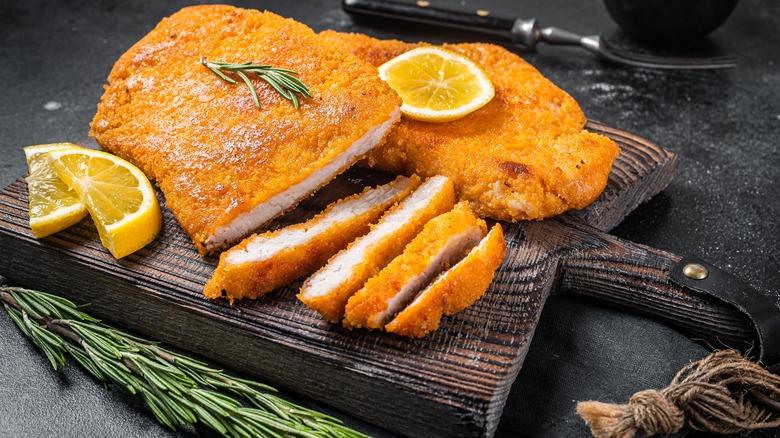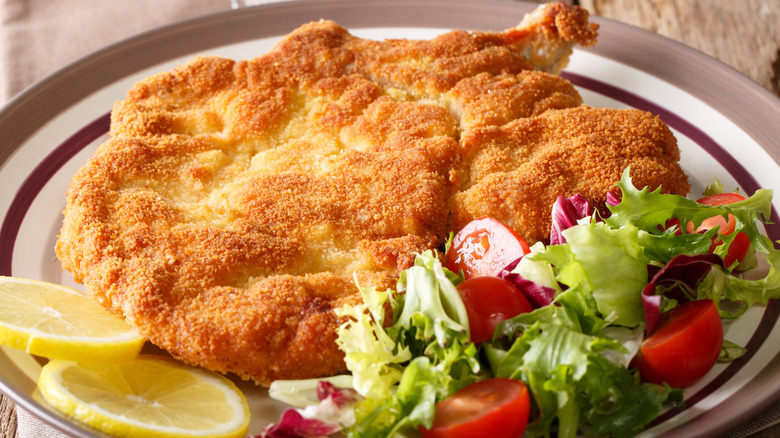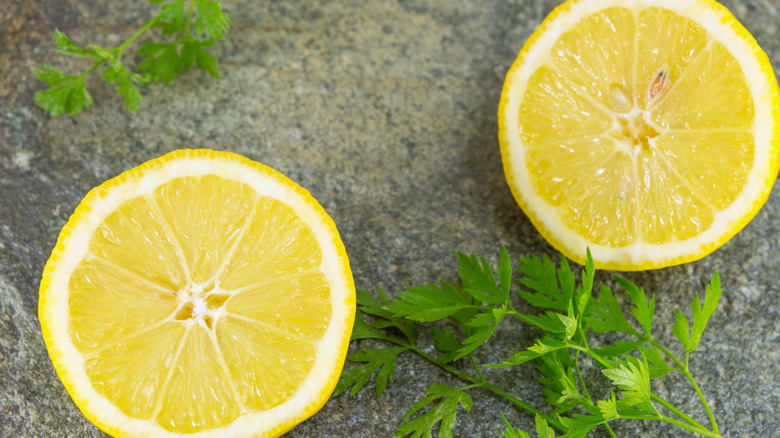The Difference Between Veal Milanese And Wiener Schnitzel
Crispy breaded cutlets of tender veal, bursting with texture and flavor; versions of this dish are ubiquitous in many cultures around the west from central Europe to Scandinavia, and even the United States. Perhaps the most well known rendition of this food is Austria's national dish, wiener schnitzel, which is so central to the country's cuisine that the ingredients that make up the dish are defined by law.
All that being said, this classic meal has a close cousin to the southwest that originates in Italy. Veal Milanese may sound nearly identical to wiener schnitzel upon a quick read of a recipe, but there are some key differences that make each dish unique.
Both dishes have a hearty, savory flavor profile and combine the richness of luscious veal cutlets with the crispy texture of a breadcrumb coating. But regional traditions, techniques, and ingredients distinguish the two from each other. The specific cut of meat, breading and cooking techniques, and the accompanying sides make wiener schnitzel and Veal Milanese two distinctly different but equally delicious dishes.
A matter of tradition, technique, and ingredients
Wiener schnitzel is the national dish of Austria and originates from the country's capital, Vienna. The name translates to "Viennese cutlet" in German and because the dish is such an essential part of Austria's food culture, it must be made with veal in order to be called wiener schnitzel. The dish is traditionally made with cuts of boneless chops from the rump or flank of the animal. The meat is dredged in flour, dipped in egg, coated in breadcrumbs, and deep fried in animal fat like lard or butter. The result is a juicy, tender cutlet of meat that's rich with texture and flavor without being too heavy.
Veal Milanese is similar to wiener schnitzel, but this Italian dish differs in ingredients and cooking techniques. One of the key differences in these two dishes is that while wiener schnitzel always uses boneless cutlets, Veal Milanese traditionally uses a bone-in cut from the loin, though boneless is still common and acceptable. Both dishes use the technique of pounding out the meat for a thin and tender cutlet, but the breading ingredients and cooking techniques are not the same. One of those ingredients is an expected Italian staple: Parmesan cheese. The cheese is commonly mixed in with the bread crumbs for an extra dash of savory umami flavor. When it comes to cooking methods, Italians give the veal a light pan fry in olive oil or butter.
It's all about the garnish and sides
While the specific cut of meat and cooking techniques are the biggest differences between wiener schnitzel and Veal Milanese, the sides and garnishes matter, too. While other cultural renditions of this dish often include sauces or gravies, both wiener schnitzel and Veal Milanese keep it light and simple. The accompaniments for both dishes are meant to bring balance to the meal, but the specific sides for traditional wiener schnitzel and Veal Milanese are different.
Wiener schnitzel is garnished with a wedge of lemon and often a sprinkle of fresh parsley, offering bright and contrasting flavors compared to the heavy richness of the meat. Classic sides to accompany wiener schnitzel include German potato salad or cucumber salad, both of which also help to balance the flavors of the veal cutlet. Veal Milanese is traditionally served with a light green salad, often arugula, and a splash of lemon. Similar to the parsley and lemon in wiener schnitzel, this adds acidity and helps to balance the dish.


